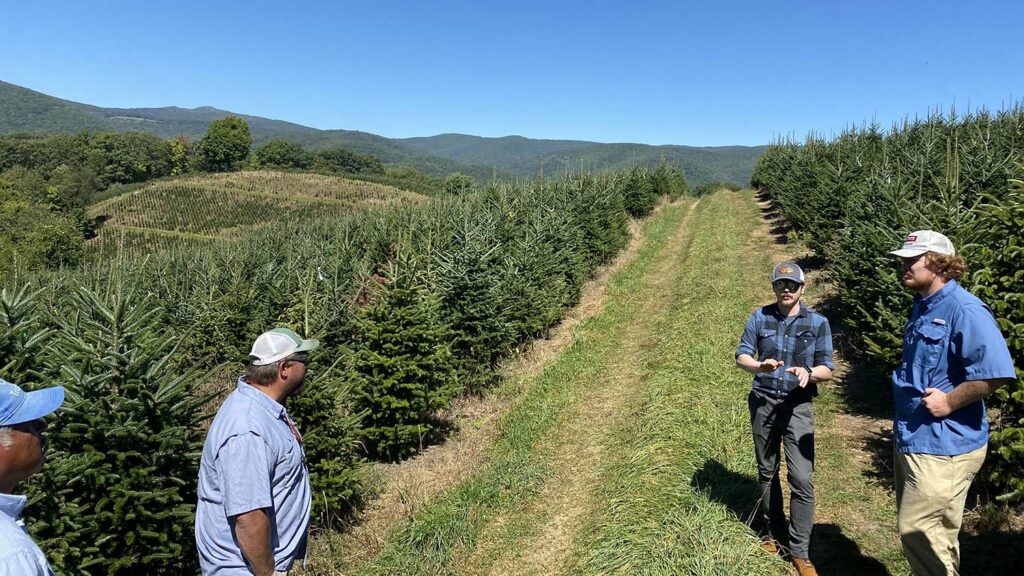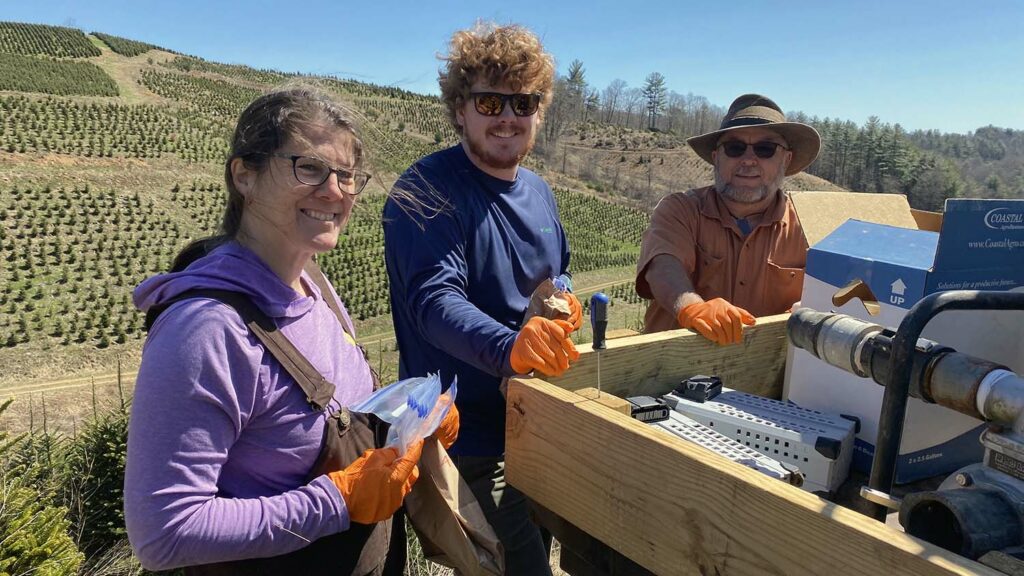Christmas Trees Are Plentiful a Year After Hurricane Helene
go.ncsu.edu/readext?1105949
en Español / em Português
El inglés es el idioma de control de esta página. En la medida en que haya algún conflicto entre la traducción al inglés y la traducción, el inglés prevalece.
Al hacer clic en el enlace de traducción se activa un servicio de traducción gratuito para convertir la página al español. Al igual que con cualquier traducción por Internet, la conversión no es sensible al contexto y puede que no traduzca el texto en su significado original. NC State Extension no garantiza la exactitud del texto traducido. Por favor, tenga en cuenta que algunas aplicaciones y/o servicios pueden no funcionar como se espera cuando se traducen.
Português
Inglês é o idioma de controle desta página. Na medida que haja algum conflito entre o texto original em Inglês e a tradução, o Inglês prevalece.
Ao clicar no link de tradução, um serviço gratuito de tradução será ativado para converter a página para o Português. Como em qualquer tradução pela internet, a conversão não é sensivel ao contexto e pode não ocorrer a tradução para o significado orginal. O serviço de Extensão da Carolina do Norte (NC State Extension) não garante a exatidão do texto traduzido. Por favor, observe que algumas funções ou serviços podem não funcionar como esperado após a tradução.
English
English is the controlling language of this page. To the extent there is any conflict between the English text and the translation, English controls.
Clicking on the translation link activates a free translation service to convert the page to Spanish. As with any Internet translation, the conversion is not context-sensitive and may not translate the text to its original meaning. NC State Extension does not guarantee the accuracy of the translated text. Please note that some applications and/or services may not function as expected when translated.
Collapse ▲It’s been just over a year since Hurricane Helene’s path of destruction through western North Carolina, and impacts are still being felt in the agriculture and horticulture industries.
But there is good news for producers and consumers. The North Carolina Christmas tree industry endured the worst the storm had to offer, and continues to thrive. There are plenty of beautiful evergreens available for customers in the state and across the country.
“If they want the premier Fraser fir from North Carolina, there are ample out there,” said Blake Williams, horticulture agent with NC State at N.C. Cooperative Extension’s Ashe County center.
A Holly, Jolly Outlook for the Season
Throughout the mountain counties, trees are being harvested, loaded onto trucks, and shipped to tree lots and garden centers. Choose-and-cut operations are welcoming visitors who prefer to get their tree at the source.
“We’ve had a great harvest season so far. I don’t know of anyone that is running behind schedule,” said Jerry Moody, director and horticulture agent at the Extension center in Avery County. “Customers should have no problem finding the tree that they want. And the quality looks fantastic. It looks really good this year. All in all, it’s been a much less stressful year.”

Jerry Moody, director of the N.C. Cooperative Extension center in Avery County, inspects a Fraser fir at a Christmas tree farm in the county. Extension Christmas tree experts are keeping a wary eye out for evidence of phytophthora root rot, a pathogen that thrives in the wet conditions prevalent after Hurricane Helene.
That’s in stark contrast to 2024, which might have been the most stressful year in the industry’s history.
North Carolina is second in the nation in production, behind only Oregon, with upward of 5 million trees harvested each year. Ashe is either the first or second tree-producing county, tussling annually with Clackamas County in Oregon for the top spot.
The state is first in Fraser firs, which are native to the southern Appalachians. Frasers generally are regarded as the most popular Christmas trees because of their strong branches, pleasant scent and needle retention.
Trees from North Carolina are sold throughout the state and across the country.
“We always say that North Carolina Christmas trees go to all 50 states,” Williams said. “Trees from North Carolina have been shipped to Hawaii, Puerto Rico, all over the place. One of our agents was in Jamaica last year and even saw them there. But truthfully, where the divide really happens is the Rockies. If you can imagine the continental U.S., our range is the East Coast all the way to the Midwest, and Oregon’s is the West Coast to the Midwest.”
The Christmas tree industry is important to the economy of western North Carolina, generating more than $150 million in sales and supporting more than 7,000 jobs.
Helene’s Impact and the Road to Recovery
Those numbers were in peril in the aftermath of Helene. The massive storm pummeled western North Carolina in late September last year. Landslides took out whole fields. Wind damage harmed the crop.

Heavy rains from Hurricane Helene produced landslides that destroyed thousands of Christmas trees in 2024. Despite the losses, this year’s harvest is plentiful.
“We had sections of the county that experienced tremendous losses,” Williams said.
The biggest concern was infrastructure. The storm washed out numerous roads just weeks before harvest time. Growers were faced with a logistical nightmare. How to get their trees to market on roads that no longer existed?
Williams and Moody were among the Extension experts who worked closely with the N.C. Department of Transportation to prioritize repairing and reopening roads to rescue the industry, benefiting growers and consumers.
Related: North Carolina Christmas Trees Weathered the Storm
Those logistical worries are largely in the past. Most roads have been repaired or replaced, making it easier for growers to get trees off the mountains and for tourists to get to choose-and-cut operations.
Landslides affected some growers, but tree losses were relatively minimal. The weather was good in the weeks before harvest season, a welcome change from 2024.
“This year is tremendously better than last year,” Moody said. “Everyone is just relieved they’re not having to fight the effects of a hurricane this year. I think that alone has decreased the stress level for everyone.”

NC State Extension Christmas tree experts Brad Edwards, Will Kohlway and Blake Williams teach farm workers how to evaluate tree health using field scouting techniques. Photo by Jamie Bookwalter
There are some hurricane-induced issues for Christmas tree growers. It takes up to 10 years for a Fraser fir to reach the optimal market range of 6 to 7 feet, so producers who lost trees will take a while to fully recover.
Extension Christmas tree experts also are keeping a wary eye out for the emergence of tree-killing diseases in the post-Helene period.
“We’re concerned about whether all the rain created more disease in some of our fields,” Moody said. “We have heard from some growers saying they have more trees dying in a certain area than in the past. We’ve been looking into it and trying to track it and quantify it. We’re hoping to mitigate that problem.”
The biggest area of concern is phytophthora root rot, a pathogen that thrives in wet conditions and is known to attack Fraser firs.
“The real fear after Helene was seeing phytophthora spread like wildfire,” Williams said. “It is in a group of fungus called water molds. Whenever we have extremely wet conditions, we always run the chance of them just multiplying out of control. Typically phytophthora is about a 15% mortality for North Carolina Christmas trees. This year we’ve experienced closer to the 18- to 20% range. We definitely are seeing an uptick, but it’s not an overly concerning uptick just yet.”

Extension Christmas tree specialists Jamie Bookwalter, Matthew Carson, Brad Edwards , John Council, Emma Durr (intern), and Blake Williams after setting up a containerized Fraser fir nitrogen study to evaluate the relationship between nitrogen rates and scale insect infestation.
Local experts like Williams and Moody are supported by NC State Extension Christmas tree specialists whose areas include genetics, integrated pest management, and production and marketing. They will continue to monitor for phytophthora root rot and other diseases and for pests that threaten to damage trees, and to conduct research to help ensure the health of the industry.
They will communicate with each other about issues in their counties, and share information that will help growers.
“We talk regularly,” Williams said. “We’ll often replicate trials, and we try to be as collaborative as we can to support the industry. We don’t just rely on spraying and praying. We rely a lot on scouting. We go through our fields to make sure that the pests and the issues that we think might be there actually are there and are at levels of concern.”
Related: Growing Christmas Trees for the Future

Paige Patterson, NC State Extension horticulture agent in Watauga County, Ashe County horticulture agent Blake Williams and Jerry Moody, director of N.C. Cooperative Extension center in Avery County, prepare for a field trial evaluating pesticide spray coverage between modern aerial drones and traditional high-pressure sprayer systems. Photo by Jamie Bookwalter
There are always some levels of concern in any industry related to agriculture. But growers and consumers can be thankful there are fewer this year in a business that is important to so many.
“It’s hard for anyone really to hate Christmas trees and Christmas,” Williams said. “We have great growers across the board in western North Carolina. They definitely are some of the most resilient people you could ever meet. After Helene, we really got to see them come into their own and handle that kind of situation. You can see the impacts you make. It’s very rewarding and it drives you. It’s very motivating.”
Christmas Tree Facts
- North Carolina has approximately 1,300 growers producing Fraser fir Christmas trees on an estimated 40,000 acres.
- Fraser fir represents over 99% of all species grown in North Carolina.
- Fraser fir is grown in the far western North Carolina counties, including Alleghany, Ashe, Avery, Buncombe, Haywood, Henderson, Jackson, Macon, Madison, Mitchell, Swain, Transylvania, Watauga and Yancey.
- The North Carolina Christmas Tree Industry is ranked No. 2 in the nation in number of trees harvested and cash receipts.
- North Carolina produces more than 20% of the Christmas trees in the U.S.

